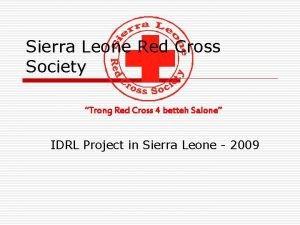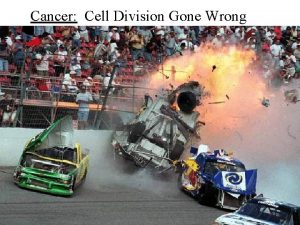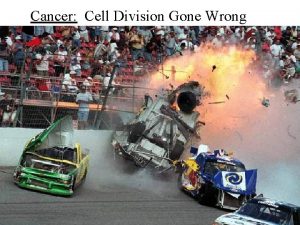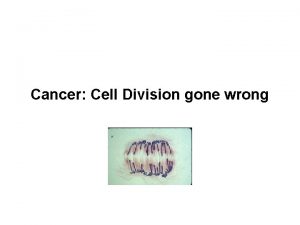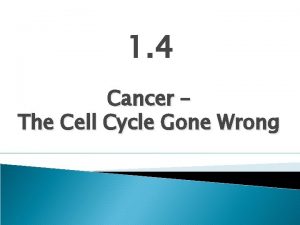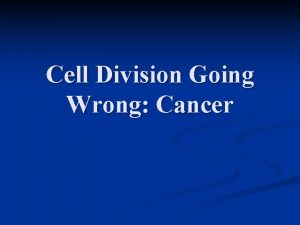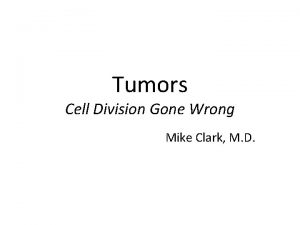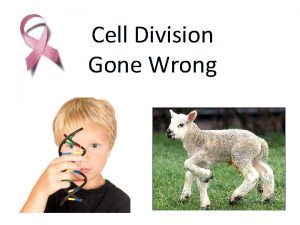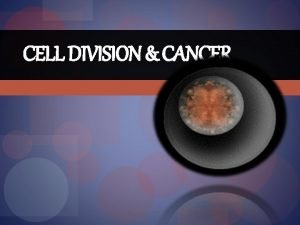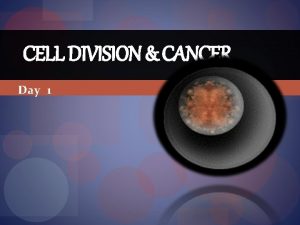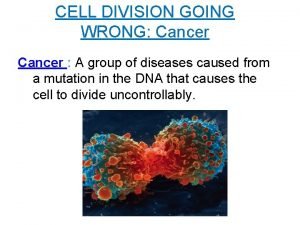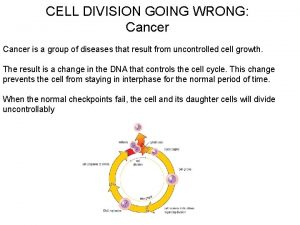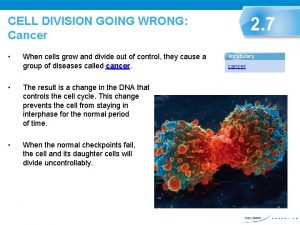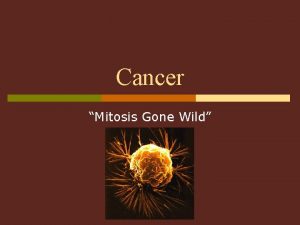Cell Division Gone Wrong Cancer Rates of Cell































- Slides: 31

Cell Division Gone Wrong…. Cancer

Rates of Cell Division • • Inner lining of small intestine – a week or less Pancreas – a year or more Liver – Cell rarely divide unless injured Skin – Cells will divide to replace cells ▫ Healthy skin – lower rate of cell division • Cancer – Greater rate than the surrounding tissue

What is Cancer? • A mutation that occurs in a cell’s DNA that increases it’s rate of cell division

What is Cancer? • A Cancer cell keeps dividing despite messages from the nucleus to stop growing and dividing

Tumour Colon Cancer Cells • Rapidly growing cells that form a lump • May or may not affect surrounding cells.

Benign Tumour • A growth with no serious effects on surrounding tissue except crowding of cells.

Malignant Tumour • A growth that interferes with the function of neighbouring cells and tissues • Can destroy surrounding tissue

Secondary Tumours • A group of cells which breaks away from the original (primary) tumour. • Metastasis – The process of a cancerous cell travelling through the body to settle in a new location.

Metastatic Cancer Tumours found in the colon might not be colon cancer.

Lung Cancer

Cancer Video

Mitosis Gone Wrong Prostrate Cancer Cell Lung Cancer Cell Breast Cancer Cell

Cell Division leading to Benign and Malignant Tumours

Causes of Cancer • Carcinogens – environmental factors ütobacco smoke üRadiation (x-rays) üUV rays (sun, tanning beds) üSome viruses üChemicals in some plastics

Causes of Cancer • Hereditary üCalled inherited cancer üAn abnormal gene (piece of DNA) is passed from parent to child that can potentially cause cancer üEx. Genes associated with breast and colon cancers

Diagnosing Cancer screening – Increase the chance for early detection and treatment.

Cancer Screening • Check to see if inherited DNA is linked to cancer; important with family history of breast or colon cancer. Breast Cancer Cells Colon cancer

Cancer Screening Irregular Mole • Breast Cancer – regular self examination • Cervical Cancer – regular pap smears • Testicular Cancer – testicular self exam • Prostate Cancer – blood test • Skin Cancer – check moles for “ABCD” ØAsymmetry, Border, Color, and Diameter


Diagnosing Cancer Imaging Technology • Endoscopy – camera, cable sent into the body to look at tissue and remove tissue samples

Diagnosing Cancer • X-ray – to view bones/lungs • Mammogram – to view breast tissue • Ultrasound – sound waves create a digital image

Diagnosing Cancer • CT or CAT scan – multiple x-rays assembled in an image more detailed than x-rays • MRI – radio waves create 3 D models of images

Diagnosing Cancer • Biopsy – look at a sample of cells under a microscope.

Treatment for Cancer • Surgery – removal of cancerous tissue • Chemotherapy • specific drugs to slow/stop cancer division • side effects – hair loss, nausea, fatigue

Treatment for Cancer • Radiation • damages Cancer DNA • focused beam or implant

Treatment for Cancer • Biophotonics • uses light energy to diagnose and treat living cells • fewer side effects • accurate target with cancer cells

Radiation Technology • Video

Reducing the Risk • Lifestyle choices: üHealthy Diet – lots of fruits and vegetables, reduced fatty meat. üExercise – some cancers are associated with higher body fat.

Reducing the Risk üAvoid Smoking - every cigarette feeds your body with chemicals which covert in your body to toxic compounds which change the DNA of body cells.

Vocabulary! Tumour Benign Tumour Malignant Tumour Mutations Ultrasound Carcinogens Endoscopy CT scan Biophotonics MRI Chemotherapy

Homework! • Page 55 • Questions #1 - 10
 Plastic surgery gone wrong
Plastic surgery gone wrong Must 의문문
Must 의문문 Plexr plasma
Plexr plasma Masseter botox placement
Masseter botox placement What is mitosis gone wild
What is mitosis gone wild You put the wrong emphasis on the wrong syllable
You put the wrong emphasis on the wrong syllable Unit rate vocabulary
Unit rate vocabulary Ratios and proportions guided notes
Ratios and proportions guided notes Ratios rates and unit rates
Ratios rates and unit rates Ratios rates and unit rates
Ratios rates and unit rates Prostate
Prostate Cell cycle and cell division
Cell cycle and cell division Cell cycle and cell division
Cell cycle and cell division Cell cycle mitosis
Cell cycle mitosis Long division and short division
Long division and short division F(3)
F(3) H.c.f
H.c.f Synthetic fivision
Synthetic fivision Where have you gone charming billy
Where have you gone charming billy Gone too far childnet
Gone too far childnet Christina rossetti remember
Christina rossetti remember Went vs gone
Went vs gone Ride rode ridden pronunciation
Ride rode ridden pronunciation Gone too far childnet
Gone too far childnet Saigon is gone poem
Saigon is gone poem Why does janie visit jody on his deathbed
Why does janie visit jody on his deathbed My chains are broken i've been set free
My chains are broken i've been set free Sierra leone red cross society
Sierra leone red cross society Oedipus the king prologue
Oedipus the king prologue Isaiah 1:11
Isaiah 1:11 Linkedin getting started
Linkedin getting started A long way gone essay
A long way gone essay



























